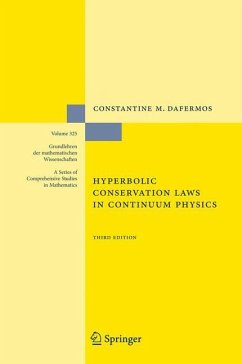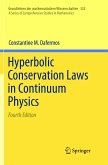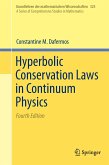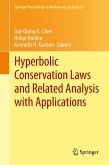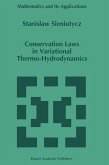The aim of this work is to present a broad overview of the theory of hyperbolic c- servation laws, with emphasis on its genetic relation to classical continuum physics. It was originally published a decade ago, and a second, revised edition appeared in 2005. It is a testament to the vitality of the ?eld that in order to keep up with - cent developments it has become necessary to prepare a substantially expanded and updated new edition. A new chapter has been added, recounting the exciting recent developmentsin classical open problems in compressible ?uid ?ow. Still another - dition is an account of the early history of the subject, which had an interesting, - multuous childhood. Furthermore, a substantial portion of the original text has been reorganized so as to streamline the exposition, update the information, and enrich the collection of examples. In particular, Chapter V has been completely revised. The bibliography has been updated and expanded as well, now comprising over - teenhundred titles. The background, scope, and plan of the book are outlined in the Introduction, following this preface. Geometric measure theory, functional analysis and dynamical systems provide the necessary tools in the theory of hyperbolic conservation laws, but to a great - tent the analysis employscustom-madetechniques,with strong geometric?avor, - derscoring wave propagation and wave interactions. This may leave the impression that the area is insular, detached from the mainland of partial differential equations.
From the reviews of the second edition:
"The second edition of the famous book Grundlehren der Mathematischen Wissenschaften 325 is devoted to the mathematical theory of hyperbolic conservation and balance laws. The author is known as one of the leading experts in the field. His masterly written book is, surely, the most complete exposition in the subject of conservations laws. ... the original text has been reorganized so as to streamline the exposition, enrich the collection of examples, and improve the notation. ... The bibliography has been considerably expanded ... ." (Evgeniy Panov, Zentralblatt MATH, Vol. 1078, 2006)
"This comprehensive book is about rigorous mathematical theory of balance and conservation laws ... . The statements of theorems are carefully and precisely written. The proofs are canonical and illuminating ... . This book is sure to convince every reader that working in this area is challenging, enlightening, and joyful. I heartily recommend this book to anyone who wants to learn about the foundations of the theory of balance and conservation laws and their generic relations to continuum physics ... ." (Katarina Jegdic, SIAM Review, Vol. 48 (3), 2006)
From the reviews of the third edition:
"Covers the existence, uniqueness, continuous dependence, and qualitative behavior of entropy solutions for, successively, scalar conservation laws, systems of two conservation laws, and general strictly hyperbolic systems. ... This book is now widely recognized as the 'Bible' on hyperbolic conservation laws, and has contributed to the training of many students while providing a huge amount of invaluable information (including a 100 page bibliography) for researchers working in this field or related areas." (Philippe G. LeFloch, Mathematical Reviews, Issue 2011 i)
"The third edition of the famous book by C. M. Dafermos ... devoted to the mathematical theory of hyperbolic conservation and balance laws. This masterly written book is, surely,the most entire exposition in the subject of conservation laws." (Evgeniy Panov, Zentralblatt MATH, Vol. 1196, 2010)
"The second edition of the famous book Grundlehren der Mathematischen Wissenschaften 325 is devoted to the mathematical theory of hyperbolic conservation and balance laws. The author is known as one of the leading experts in the field. His masterly written book is, surely, the most complete exposition in the subject of conservations laws. ... the original text has been reorganized so as to streamline the exposition, enrich the collection of examples, and improve the notation. ... The bibliography has been considerably expanded ... ." (Evgeniy Panov, Zentralblatt MATH, Vol. 1078, 2006)
"This comprehensive book is about rigorous mathematical theory of balance and conservation laws ... . The statements of theorems are carefully and precisely written. The proofs are canonical and illuminating ... . This book is sure to convince every reader that working in this area is challenging, enlightening, and joyful. I heartily recommend this book to anyone who wants to learn about the foundations of the theory of balance and conservation laws and their generic relations to continuum physics ... ." (Katarina Jegdic, SIAM Review, Vol. 48 (3), 2006)
From the reviews of the third edition:
"Covers the existence, uniqueness, continuous dependence, and qualitative behavior of entropy solutions for, successively, scalar conservation laws, systems of two conservation laws, and general strictly hyperbolic systems. ... This book is now widely recognized as the 'Bible' on hyperbolic conservation laws, and has contributed to the training of many students while providing a huge amount of invaluable information (including a 100 page bibliography) for researchers working in this field or related areas." (Philippe G. LeFloch, Mathematical Reviews, Issue 2011 i)
"The third edition of the famous book by C. M. Dafermos ... devoted to the mathematical theory of hyperbolic conservation and balance laws. This masterly written book is, surely,the most entire exposition in the subject of conservation laws." (Evgeniy Panov, Zentralblatt MATH, Vol. 1196, 2010)
"This book is a contribution to the fields of mathematical analysis and partial differential equations and their broad interactions with various branches of applied mathematics and continuum physics, whose value cannot be overstated. ... a useful resource for a variety of courses as well as an almost encyclopedic reference point for advanced researchers. ... It is a great achievement that will influence the PDEs and mathematical analysis community for years to come." (Marta Lewicka, Mathematical Reviews, November, 2017)

